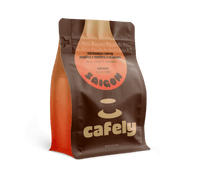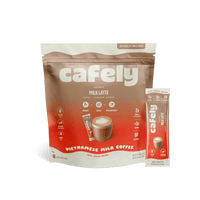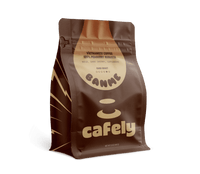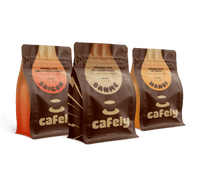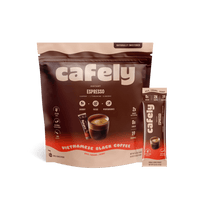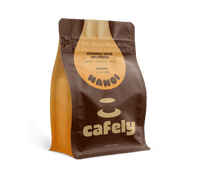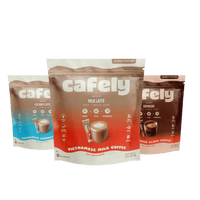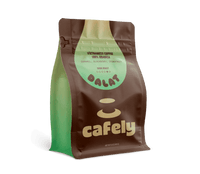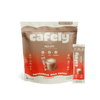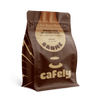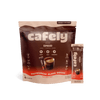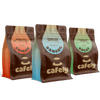Finding exceptional coffee isn't just about brand names or price points — it's about understanding what makes coffee taste great and knowing what to look for based on your preferences.
Whether you're a casual coffee drinker or a dedicated enthusiast, this guide will help you identify the qualities that separate outstanding coffee from the ordinary.
Understanding Coffee Quality Fundamentals
The best-tasting coffee starts with three key factors:
- Bean quality
- Processing methods
- Freshness
Great coffee begins at the origin with careful cultivation, continues through proper processing and roasting, and ends with proper storage and brewing.
Quick Reference: Finding Your Perfect Coffee
- Arabica coffee — For the best-tasting arabicas, look for high-altitude-grown beans (3,000+ feet) from regions like Ethiopia, Jamaica, or Central America.
- Robusta coffee — The best-tasting robusta beans come from Vietnam's Central Highlands. Traditional shade-growing methods can further improve flavor but also increase the cost.
- Light roast — Best for showcasing origin flavors—look for floral, fruity, or tea-like qualities with no surface oils.
- Medium roast — Balanced sweetness and body with medium brown color and minimal surface oil.
- Dark roast — Rich, bold flavors with slight oil sheen—avoid burnt or overly bitter beans
- Single-origin vs blends — Single-origins showcase unique regional characteristics, while blends balance seasonal fluctuations in flavor.
- Instant coffee — Choose freeze-dried options made from 100% arabica beans with specified origins.
- Processing methods — Opt for washed if you prefer clean/bright flavors, natural for more fruity notes, or honey processing if you prefer sweeter coffee.
- Freshness indicators — Look for coffee that's been roasted within 2-4 weeks for the best flavor.
Top 3 Best Tasting Cafely Coffees
We're dedicated to providing the best-tasting coffee on Earth. We source all our beans from local family-owned farms that use all-natural, organic, and sustainable farming methods.
Our roasting is done in-house every 1–2 weeks depending on demand to ensure every delivery is as fresh as possible.
1. Cafely SaiGon OG Traditional Vietnamese Coffee (Butter Roasted)

Cafely's SaiGon OG Coffee is an impressively balanced blend of robusta, arabica, and peaberry coffee beans designed to reflect the essence of Saigon’s resilient spirit.
The combination of different beans provides a range of distinct flavors. The robusta beans construct a rich, earthy base, upon which the arabica builds with smooth, nutty, and aromatic tasting notes.
Finally, there's peaberry beans, which are known for their concentrated sweetness, are added to enhance the profile by perfectly combining depth and smoothness.
Cafely SaiGon OG Traditional Vietnamese Coffee Product Specs:
- Strength — ☕☕☕☕
- Origin — Vietnam
- Body — Full-bodied
- Roast Level — Dark roast
- Acidity — Low
- Process —Mixed (Washed & Natural)
- Flavor Notes — Butter, roasted nuts, and cocoa
2. Cafely BanMe 100% Peaberry Coffee (Strongest Flavor)

Cafely’s BanMe Coffee is known for its rich, dark earthiness and achieves that flavor without compromise. Made entirely from peaberry robusta beans, this coffee is the strongest in the world and delivers twice as much caffeine as arabica beans. The core tasting notes include dark chocolate, black cherry, and toasted almond, making for an uncompromisingly potent brew.
The dry processing method allows the coffee cherries to be sun dried for several weeks, allowing the juiciness of the fruit to be transferred to the beans. This is what allows the coffee to exude its signature, and delicious, black cherry aftertaste.
Nuttiness is also at the core of this coffee, which is best when brewed with a phin filter in the traditional Vietnamese style. The combination of pressure and time leads to a high level of extraction in the final cup. With the BanMe coffee, that intensive extraction distills a vast amount of flavor and caffeine, making it the perfect afternoon pick-me-up.
Cafely’s BanMe 100% Peaberry Coffee Product Specs:
- Strength — ☕☕☕☕☕
- Origin — Vietnam
- Body — Full-bodied
- Roast Level — Dark roast
- Acidity — Low
- Process: Natural Dry Processing
- Flavor Notes — Dark chocolate, toasted almond, and black cherry
3. Cafely DaLat 100% Arabica Coffee (Smoothest Flavor)

Cafely's DaLat 100% Arabica Coffee is a more delicate option than some others and is made entirely from arabica beans.
These beans are grown in the Vietnamese highlands, a place long lauded for its coffee culture. The region is exceptionally beautiful, and that beauty is transferred into the coffee beans, with notes of caramel, blackberry, and stone fruit at the front and center.
Arabica beans make up 60% of the world’s coffee, and tend to have complex flavors without the bitterness, providing some of the smoothest, sweetest, and fruitiest flavors.
Cafely’s DeLat 100% Arabica Coffee Product Specs:
- Strength — ☕☕☕
- Origin — Vietnam
- Body — Full-bodied
- Roast Level — Dark roast
- Acidity — Medium
- Process: Washed
- Flavor Notes — Caramel, blackberry, and stone fruit
How to Identify the Best-Tasting Coffees
Finding the ideal coffee flavor for your palate can seem super complex, especially since the world of coffee is vast, and makes the range of flavors you can experience overwhelming.
Similar to wine, coffee beans inherit their flavor and aromatic profiles from where they are grown and harvested, and how they are processed, roasted, and brewed. Next, we’ll dive deeper into how those factors contribute to your search for the perfect coffee.
Key Factors to Consider When Buying Coffee
Finding coffee that appeals to your personal taste buds begins with understanding some important facts about coffee and will help you navigate how and why certain coffees can taste better than others. While choosing the best option for you is ultimately subjective, there are some primary considerations to keep in mind.
1. Coffee Source
The location where coffee is sourced plays an integral role in its ultimate taste and flavor profile. Different regions have different climates, soil composition, altitude, and farming practices, all of which translate to the final bean.
For example, African coffees produced in Kenya and Ethiopia tend to have fruity, floral, and brighter notes, while Central and South American coffees are generally less acidic and more nutty and balanced.
Coffee sourced from Vietnam, like Cafely’s Vietnamese Coffee Collection, features robust flavors that are bold, nutty, and intensely satisfying.
2. Certified Organic

Organic coffee beans are grown without the use of pesticides and other extremely harsh chemicals. The plants grow more naturally, allowing the inherent coffee flavors to shine in every bean.
Organic farming is better for the planet and better for your morning cup, too. When trying to pick the best coffee, always look for best certified organic options for the best results.
3. Coffee Beans
As we’ve already discovered, different coffee beans are known for different flavor profiles.
Coffee flavors based on the type of coffee bean include:
- Arabica — Sweet, nutty, fruity, and more acidic
- Robusta — Robust, earthy, winey, and less acidic
- Peaberry — Bright acidity, sweet, intense flavor
When shopping for your preferred coffee, consider the type of coffee bean that is used to help determine the flavor you’ll enjoy most.
4. Processing Method
The way coffee is processed also plays a role in how it actually tastes. There are two main processing types, dry and wet processing.
Dry processing involves picking the coffee cherries and allowing the sun to dry them for several weeks. This process transfers the flavor of the coffee cherry itself to the coffee bean, producing complex, full-bodied flavors.
Wet processing involves picking the coffee cherries, removing the skin, and allowing the beans to ferment. This fermentation process enhances the natural compounds in the coffee bean and results in brighter, cleaner flavor profiles.
5. Roast Level
Another factor that plays into the flavor of coffee is how the beans are roasted. Different types of roasts provide significant changes in taste and are often used for different types of coffee beverages.
How roast contributes to coffee’s flavor:
- Light Roast — Delicate, fruity, brighter, and higher acidity
- Medium Roast — Balanced, chocolatey, nutty, caramelly, and full-bodied
- Dark Roast — Bold, rich, roasty, dark, full-bodied, and pleasantly robust
Another example includes espresso roast, which is usually much darker than other roasts, and while it may not be as enjoyable to drink as a standard cup of coffee, it lends itself perfectly for shots of espresso used in specialty beverages.
6. Tested for Safety
To know you’re drinking pure, safe, and clean coffee, look for beans that have been tested and certified mold-free.
Some crops, when shipped internationally, can grow mold colonies on them. This occurs when they’re processed or stored improperly. Mold can leave behind mycotoxins, which can be quite dangerous.
7. Fair Trade Certified
The Fair Trade certification on a bag of coffee means that the company is responsible, empowers farmers, workers, and protects the environment. Therefore, the farmer and the roaster both walk away happy without harming the Earth.
For confidence and peace of mind, always opt for companies that are Fair Trade certified.
8. Freshness
When coffee is fresh out of the roaster, it releases a lot of CO2. After around 24 hours, it’s at its peak level of flavor, and the flavor begins to slowly diminish from there. To make sure your coffee is packed with flavor, get the freshest possible beans you can.
A reputable roaster will clearly print the roasting date on every bag of coffee, providing consumers with full transparency.
9. Added Ingredients
Unfortunately, there are some coffee roasters that will use added sugars and artificial flavors to mask any mistakes that they made in processing. To get the highest quality beans, look for coffee with no added sugar, or coffee that only uses natural sweeteners like monk fruit to enhance the complex flavors already present.
>> Try the Best Vietnamese Coffee Sweetened with Monk Fruit Here!
Your Personal Taste
Catering to your personal preferences can be a little trickier than following the guidelines above. However, one of the surefire ways to find delicious coffee is to compare different options until you find your preferred flavor profile.
There’s an ocean of different coffee options out there, and by experimenting with a wide range of coffee sources, beans, and roasts, you may be surprised at what tastes best.
A good starting point for most people is to try a medium roast. This roasting level is very balanced and retains the nutty, citrusy notes in coffee, while developing toasty sweetness without too much acidity.
Why Is Vietnamese Coffee So Good?
Vietnam produces a staggeringly huge amount of the world’s coffee for such a small country. In fact, according to the USDA, Vietnam is the second-largest coffee producer.
How do Vietnamese farmers achieve this feat? There are two main reasons for the success of Vietnamese coffee production: the Vietnamese Highlands and Vietnamese coffee traditions.
Vietnamese Central Highland Region
The Vietnamese Central Highlands are where the bulk of coffee is grown in the country, with high-elevation slopes covered with coffee trees.
The soil in the region is volcanic, meaning it’s packed with minerals and bacteria that all plants need to thrive. In the case of coffee plants, this nutrient-dense soil is ideal since it allows the coffee trees to flourish and improves the flavor of the coffee bean itself.
Additionally, the warm, tropical climate, high humidity, and weak direct sunlight help improve the quality of robusta coffee beans, the primary coffee produced in Vietnam.
>> Try the Most Delicious Robusta Coffee from Vietnam Here!
Vietnamese Coffee Traditions

Vietnamese coffee traditions are long and storied, with many centuries-old practices being commonplace even today.
The most famous Vietnamese coffee traditions include:
- Butter Roasting — This practice of butter roasting turbo-charges the natural chemistry of every bean, leading to a caramelized, indulgent flavor in the final cup.
- Sweetened Condensed Milk — Speaking of indulgent flavor, sweetened condensed milk is a super popular addition to coffee in Vietnam. It’s often used to create a rounded sweetness that balances with the satisfying bitterness of black coffee.
- Phin Filter — A phin filter is a brewer that uses fine mesh and fine coffee in concert with gentle, constant pressure to achieve maximum extraction. This leads to a cup of coffee that’s exceptionally strong, offering powerfully bittersweet flavors alongside a caffeine kick.
These practices are commonplace in Vietnam, and coffee beverages with these features are often sold by street vendors.
The strong, delicious, and potent flavor profiles of coffee from Vietnam are well-loved, contributing to Vietnam’s success in the coffee business worldwide.
How to Brew Your Coffee for Complex, Rich Flavors
Brewing the best-tasting coffee out there is a tall order. However, with the deliberate use of some key methods, it’s possible to make stellar brews every time.
Before we even get started, let’s quickly make a note about the best way to store coffee beans. The flavor compounds in coffee beans are volatile, which means they will evaporate and be lost over time. To prevent this from happening, we need to manage four things: heat, light, airflow, and moisture.
Keep all your coffee beans inside an airtight, opaque container in a cool, dry place. That way, your beans have the most flavor possible when you come to use them.
Next, we’re going to talk through the key steps to brew a great pour-over coffee.
What You Need to Make Pour-Over Coffee
The pour-over coffee brewing method is a super effective way to get a delicate, balanced taste from your coffee beans without being overly complicated.
All you need are basic ingredients and a few simple pieces of equipment.
Ingredients
- Premium coffee
- Water
- Milk (optional)
- Sugar (optional)
Equipment
- Pour-over coffee maker
- Burr grinder (if using whole-bean coffee)
- Pan or kettle (for heating water)
- Coffee mug
- Teaspoon
Related: How to Choose the Best Coffee for Pour Over: Our Recommendations
How to Make Coffee: Pour-Over Method
Making pour-over coffee is a very easy process, but a few key techniques will help you maximize the flavor every time.
1. Setup the Brewer
For the brewer, the preparation is fairly simple — just place a mug on a digital scale, the brewer on top of your mug, and a filter into the brewer. Rinse out the filter paper with fresh water, and then dump out the rinse water. This will eliminate any papery flavors from the filter.
2. Measure & Grind Coffee
To prepare the coffee, add 15 grams of coffee beans into your grinder, and grind the beans to a medium-fine consistency. For the pour-over method, use approximately 15 grams of coffee for every 350 mL of water. If you’d like to brew more coffee at once, opt for 30 grams of coffee and 700 mL of water.
3. Boil Water
The final stage of pour-over prep is to boil the water. The best brewing temperature for coffee is 200˚F [93˚C]. If your water is too hot, it’s liable to lead to over-extraction. If the water is too cool, it may lead to under-extraction.
4. Bloom the Coffee
Start by adding the ground coffee to the rinsed filter. Give the brewer a gentle shake from side to side to level out the grounds. Some coffee aficionados like to create a small divot at the center of their coffee bed to better achieve even saturation. This isn’t strictly necessary, but feel free to experiment.
Set your scale to zero, and begin the bloom phase. Add around 50 mL of water to the coffee bed and evenly saturate it as best you can.
This phase will include a lot of bubbling, which is where carbon dioxide escapes the grounds quickly. This leads to fewer bubbles during the main phase of brewing, which leads to better contact between the water and the coffee grounds.
5. Pour-Over Brew
Pouring slowly and in a tight spiral, add around 250 mL of water to the coffee bed. Start at the center and work your way outward slowly. This method is an easy way for the grounds to be evenly saturated with water.
Allow that brewing water to draw down into the cup slowly. This may take a few minutes. The idea of brewing coffee is that all of the brewing water should pass through all of the ground coffee. By evenly saturating the coffee bed, you’re achieving this goal.
6. Enjoy
Finally, use up the last fifty mL of water to wash down the sides of the filter paper. Any grounds clinging to the sides draw into the center, allowing them to release any final touches of flavor they may contain.
Pour the coffee into your preferred cup, mug, or thermos, and enjoy. This is the time when you can incorporate your milk or sweetener of choice, based on your personal coffee preferences.
>> Get the Best Coffee for a Delicious Cup of Pour-Over Coffee Here!
FAQs: How to Find the Best-Tasting Coffee

Now that we’ve broken down some of the best coffee choices out there, let’s address some key FAQs.
1. What’s the Best-Tasting Coffee to Buy?
The best-tasting coffee out there is different for everyone. However, to find the best one for you, look for a single-origin coffee that’s been organically farmed and freshly roasted. To get started, try a medium roast for a balanced flavor.
2. What Type of Coffee Has the Best Taste?
There are two popular types of coffee beans: arabica beans and robusta beans. Neither of them has a taste that’s truly “better” than the other, and some of the best coffees in the world are made from a blend of the two. A blend is a great way to experience the earthy richness of robusta as well as the delicate sweetness of arabica.
3. What Is the Tastiest Coffee in the World?
The most popular type of coffee in the world is arabica. These beans contain a little more fat and sugar than robusta beans, which means their flavors tend to be a little more delicate and complex. Within arabica beans, the most popular origin is typically South America, which offers a nutty, smooth flavor.
4. What Is the Best Coffee for Someone Who Doesn’t Drink Coffee?
For those first starting out in the world of coffee, try a medium roast coffee, like Cafely’s DaNang Coffee, with a balanced flavor profile. These coffees tend to have sweet, nutty notes with added hints of maple and citrus and are very popular for that reason. A black coffee may be a little too intense as a starting point, so consider starting with a cafe latte or cappuccino brew.
5. What Coffee Has the Most Flavor?
The flavor in coffee all depends upon how it’s been brewed. To get the most flavor out of coffee beans, try using a Vietnamese phin filter or pour-over brewing.
6. Is Aldi Coffee Good?
Aldi coffee is typically the same as coffee from any supermarket — it can be great, and it can be subpar. To get the best of the bunch in Aldi, aim for a single-origin coffee that’s available as beans. Freshly grinding the beans before brewing will add a lot of flavor to your cup.
7. What Is the Best Coffee to Buy in Supermarkets?
Supermarket coffee can be something of a minefield — not all of the options on the shelf are created equal. Look for a bag that has a clear roasting date on it. That practice is done by reputable roasters so you know the beans are fresh when you get them. Ideally, look for beans roasted in the last two weeks.
8. What Coffee Does Starbucks Use?
Starbucks only uses arabica beans. They do this because the beans can have a slightly more complex flavor than robusta beans and are typically sweeter. Starbucks also tends to roast its beans to a very dark level, which develops the sweetness and increases the uniformity of the coffee.
9. Which Coffee Is Best and Sweet?
The sweetest coffees out there are options that are combined with natural sweeteners. Some roasters use sugar or syrups to mask flavors from a bad roast. Using natural sweeteners brings a more complex flavor that tends to work in concert with the natural flavors already in the coffee.
10. What Is the Most Luxurious Coffee?
The most luxurious coffee out there is down to personal taste, but we would always say that butter-roasted coffee is more decadent than the competition. The centuries-old method brings a smooth, buttery richness to each sip, making for a truly luxurious cup.
